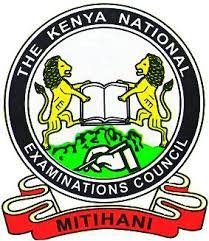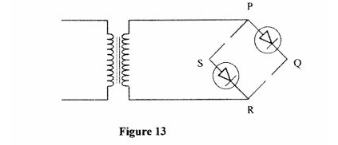
2.2.1 Physics Paper 2 (232/2)
SECTION A (25 marks)
Answer all the questions in this section in the spaces provided.
1 Figure 1, shows an object placed in front of a plane mirror.

Figure A Sketch the image of the object as seen in the mirror. (1 mark)
2 Figure 2, shows two identical pithballs A and B suspended with insulated threads. They z separated by an insulator X. A is positively charged while B is negatively charged. The quantity of charge on A is three times the quantity of charge on B.

Sketch on the space besides the figure, the final position of the pithballs after the insulator removed. (1 mark)
3 Figure 3, shows a voltmeter connected across two charged parallel plates.

Figure 3
When a thin sheet of mica is inserted between the plates, the voltmeter reading is observed to reduce. Explain this observation. (3 marks)
Figure 4, shows the cross-section of a dry cell. Use the information on the figure to answer questions 4 and 5.

Figure 4
4 Name the parts labelled A and B. (2 marks)
5 State the use of the manganese (IV) oxide in the cell. (1 mark)
6 One method of producing a weak magnet is to hold a steel rod in the North South direction and then hammer it continuously for some time. Using the domain theory of magnetism explain how this method works. (2 marks)
Figure 5, shows a motor connected to a magnetic switch called a relay operated by an ordinary switch S1. Use the information in the figure to answer questions 7 and 8.

Figure 5
7 Explain how the relay switches on the motor when S1 is closed.(3 mark)
8 State with a reason the effect on the motor, if the iron core is replaced with a steel core and switch S, is put on and then off.(2marks)
9 Figure 6, shows standing waves on a string. It is drawn to a scale of 1:5

Figure6
(a) Indicate on the diagram the wavelength of the standing wave. (1 mark)
(b) Determine the wavelength of the wave.(1 mark)
10 Figure 7 , shows two rays of light incident normally on face PQ of a glass prism, whose critical angle is 42°.

Figure 7
Complete the diagram to show the paths of the two rays as they pass through the prism. (3 marks)
11 A 4Q resistor is connected in series to a battery of e.m.f 6V and negligible internal resistance. Determine the power dissipated by the resistor. (2 marks)
12 Table l shows radiations and their respective frequencies.

Arrange the radiations in the order of increasing energy. (1 mark)
13 State the reason why electrical power is transmitted over long distances at very high voltages. (1 mark)
14 State the meaning of the term “threshold frequency” as used in photoelectric emission. (1 mark)
SECTION B (55 marks)
Answer all the questions in this section in the spaces provided.
15 (a) Figure 8, shows a graph of potential difference V (volts) against a current 1 (amperes) for a certain device.

From the graph:
(i) state with a reason whether or not the device obeys ohms law. (2 marks)
(ii) determine the resisttmce of the device at;
(ii) I = 1.5A (2 marks)
(iii) l = 3.5A (2 marks)
(iv) From the results obtained in -(ii) state how the resistance of the device varies as the current increases. (1 mark)
(iv) State the cause of this variation in resistance. (1 mark)
(b) Three identical dry cells each of e.m.f. 1 .6V are connected in series to a resistor of 11.49. A current of 0.32A flows in the circuit. Determine:
(i) the total e.m.f. of the cells; (1 mark)
(ii) the internal resistance of each cell: (3 mark)
16 (a) State the meaning of the term “principal focus” as applied in lenses. (1 mark)
(b) You are provided with the following apparatus to determine the focal length of a lens:
– a biconvex lens and lens holder.
– a lit candle.
– a white screen.
– a metre rule
(i) Draw a diagram to show how you would arrange the above apparatus to determine the focal length of the lens (1 mark)
(ii) Describe the procedure you would follow. (1 mark)
(iii) State two measurements that you would take. (2 marks)
(iv) Explain how the measurements in (m) would be used to determine the focal length. (2 marks)
(c) An object is placed 30cm in front of a concave lens of focal length 20cm. Determine the magnification of the image produced. (4 marks)
17 (a) State what is meant by the term “electromagnetic induction”. (1 mark)
(b) Figure 9, shows a simple electric generator

Figure 9
(i) Name the parts labelled P and Q. (2 marks)
P …………….
Q …………….
(ii) Sketch on the axes provided, a graph to show how the magnitude of the potential difference across R, changes with the time t. (1 mark)

(iii) State two ways in which the potential difference produced by such a generator can be increased. (2 marks)
(c) In a transformer, the ratio of primary turns to the secondary turns is 1:10. A current of 500mA flows through a 20052 resistor in the secondary circuit.
Assuming that the transformer is 100% efficient, determine:
(i) the secondary voltage; (1 mark)
(ii) the primary voltage; (2 marks)
(iii) the primary current. (2 marks)
18 (a) State two differences between cathode
(b) Figure 10, shows the main features of a cathode ray oscilloscope (CRO).

Figure 10
(i) Name the pans labelled M and N.(2 marks)
N …………….
M………………
rays and electromagnetic radiations.
(ii) Explain how electrons are produced in the tube. (2 marks)
(iii) When using the CRO to display wave forms of voltages, state where the following should be connected: (i) the voltage to be displayed on the screen; (1 mark)
(ii) the time base voltage. (1 mark)
(iii) state why the tube is highly evacuated. (1 mark)
(c) Figure 11, shows the waveform of a voltage displayed on the screen of a CRO. The Y-gain calibration was 5V per cm.

(i) Determine the peak-to-peak voltage of the Y~input.(1 mark)
(ii) Sketch on the same figure the appearance of the waveform after the voltage of the input signal is halved and it’s frequency is doubled. (2 marks)
19 (a) When a radiation was released into a diffusion cloud chamber, short thick tracks were observed. State with a reason. the type of radiation that was detected. (2 marks)
(b) The half-life of an element X is 3.83 days. A sample of this element is found to have an activity rate of 1.6 x 103 disintegrations per second at a particular time.
Determine its activity rate after 19.15 days. (2 marks)
(c) State what is meant by an extrinsic semiconductor. (1 mark)
(d) Figure 12, shows a depletion layer in an unbiased p-n junction.

Figure 12
State how a battery can be used to make the depletion layer narrower. (1 mark)
(e) Figure 13, shows an incomplete circuit of a full wave rectifier.

Figure 13
(i) Draw in the figure two more diodes to complete the circuit. (2 marks)
(ii) Show on the figure the points across which the output of the rectifier should obtained. (1 mark)
